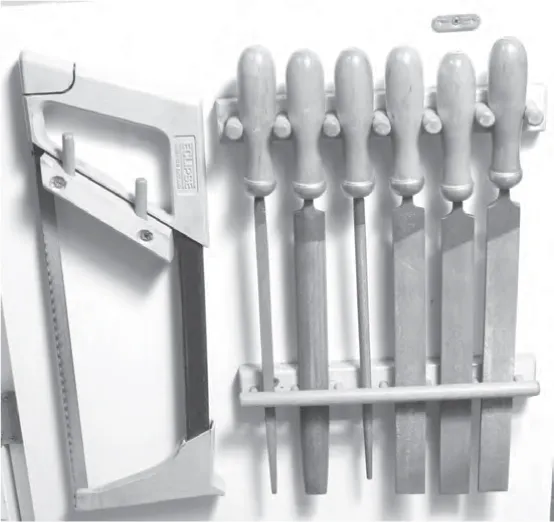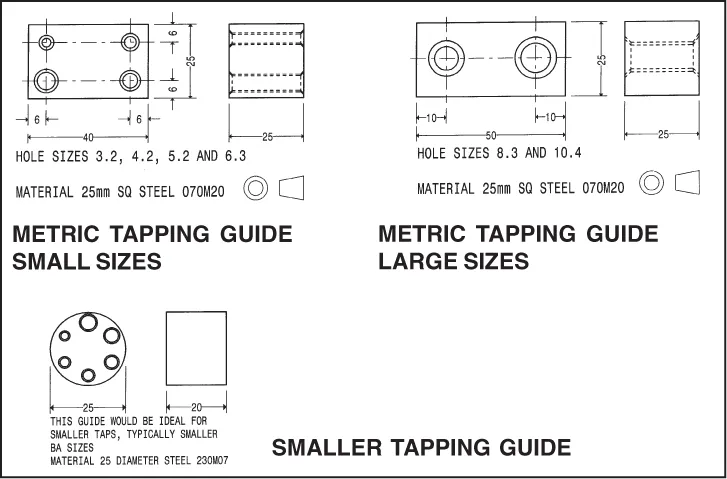
eBook - ePub
16 Metalworking Workshop Projects for Home Machinists
Practical & Useful Ideas for the Small Shop
Harold Hall
This is a test
- 250 pagine
- English
- ePUB (disponibile sull'app)
- Disponibile su iOS e Android
eBook - ePub
16 Metalworking Workshop Projects for Home Machinists
Practical & Useful Ideas for the Small Shop
Harold Hall
Dettagli del libro
Anteprima del libro
Indice dei contenuti
Citazioni
Informazioni sul libro
Create useful and essential items that can't be purchased commercially, from an auxiliary workbench and tap holders to distance and height gauges, a lathe backstop, faceplate clamps, and so much more. 16 Metalworking Workshop Projects for Home Machinists contains a collection of unique projects based on the author's most popular articles that have been published in Model Engineer's Workshop magazine. Every project is intended to make workshop tasks easier once the item is completed and ready for use.
Domande frequenti
Come faccio ad annullare l'abbonamento?
È semplicissimo: basta accedere alla sezione Account nelle Impostazioni e cliccare su "Annulla abbonamento". Dopo la cancellazione, l'abbonamento rimarrà attivo per il periodo rimanente già pagato. Per maggiori informazioni, clicca qui
È possibile scaricare libri? Se sì, come?
Al momento è possibile scaricare tramite l'app tutti i nostri libri ePub mobile-friendly. Anche la maggior parte dei nostri PDF è scaricabile e stiamo lavorando per rendere disponibile quanto prima il download di tutti gli altri file. Per maggiori informazioni, clicca qui
Che differenza c'è tra i piani?
Entrambi i piani ti danno accesso illimitato alla libreria e a tutte le funzionalità di Perlego. Le uniche differenze sono il prezzo e il periodo di abbonamento: con il piano annuale risparmierai circa il 30% rispetto a 12 rate con quello mensile.
Cos'è Perlego?
Perlego è un servizio di abbonamento a testi accademici, che ti permette di accedere a un'intera libreria online a un prezzo inferiore rispetto a quello che pagheresti per acquistare un singolo libro al mese. Con oltre 1 milione di testi suddivisi in più di 1.000 categorie, troverai sicuramente ciò che fa per te! Per maggiori informazioni, clicca qui.
Perlego supporta la sintesi vocale?
Cerca l'icona Sintesi vocale nel prossimo libro che leggerai per verificare se è possibile riprodurre l'audio. Questo strumento permette di leggere il testo a voce alta, evidenziandolo man mano che la lettura procede. Puoi aumentare o diminuire la velocità della sintesi vocale, oppure sospendere la riproduzione. Per maggiori informazioni, clicca qui.
16 Metalworking Workshop Projects for Home Machinists è disponibile online in formato PDF/ePub?
Sì, puoi accedere a 16 Metalworking Workshop Projects for Home Machinists di Harold Hall in formato PDF e/o ePub, così come ad altri libri molto apprezzati nelle sezioni relative a Technik & Maschinenbau e Technische & produzierende Gewerbe. Scopri oltre 1 milione di libri disponibili nel nostro catalogo.
Informazioni
Argomento
Technik & MaschinenbauCategoria
Technische & produzierende GewerbeChapter 1
Auxiliary Bench
This is the simplest of all the items included and without doubt the one that has repaid my time making it by more times over than any other. It is an auxiliary workbench and took me around 15 minutes to make. I did though have a suitable size piece of ply available for the top, but even if you have to cut the top to size 1 hour should be more than enough.
The bench was initially conceived for holding pieces of sheet steel for cutting using a jig saw, nibbler, etc. This was something I found difficult using my normal bench with it having only one edge available, resulting in clamps and saw wanting to share the same position. The bench, Photo 1, is about 450mm square and has a 75mm × 50mm piece of timber screwed onto the under side which is gripped in the bench vise. Photo 2, shows it being used for it original purpose.

Photo 1 An auxiliary bench with a multitude of uses

Photo 2. Being used to hold a sheet of metal while it is being cut using a jig saw.
I soon realized that in its elevated position it was also of considerable benefit when marking out, similarly, carrying out delicate assembly work, electronic or mechanical. If you have a small workshop with only limited bench space it will be a worthwhile addition if only to increase your working space, maybe larger may not be a bad idea.
If a long bolt is added to the timber bar this can be gripped in the bench vise and the top tilted to make a small drawing board, Photo 3.
File storage
While in a woodworking theme, the method of storing files on the rear of a cupboard door, Photo 4, is worth considering. It keeps them in the same place all the time so they are easily found and by keeping them apart protects their working faces. Sketch 1 shows the construction in detail. If mounted on a wall rather than on the rear of a door then the lower half could possibly be omitted.
Chuck boards
These were the result of a request from a workshop owner who was beginning to find it difficult to move his lathe chucks to and from the lathe. Additionally, aligning them with the lathe’s mandrel.
Photo 5 shows two boards, one for the three jaw and one for the four jaw. These are used on a gap bed lathe and the piece of wood in front is for placing in the gap to prevent the board tipping with the weight of the chuck. Note how the carrying handles pass in front and behind the chuck ensuring they are secure when being carried.

Photo 3 Used tilted it makes a small drawing board for use in the workshop.

Photo 4 A method of supporting files on the rear of a cupboard door.

Photo 5 These chuck boards make carrying the chucks to and from the lathe an easier operation. Also, while on the lathe’s bed they protect the bed from accidents and holding the chuck at center height assists in fitting them to the lathe’s mandrel.
To make the board place it against the chuck while fitted to the lathe and mark its edge with the shape of the chuck. Start chiseling out the shape, frequently checking it for a close fit under the chuck. The ease of screwing the three jaw chuck onto the lathe’s mandrel is further enhanced by placing a long length of rod in the chuck and loosely closing the drill chucks jaws onto the other end. This will align the chuck with the mandrel making the process a simple one.
Having started with a woodworking theme, in the next chapter we get down to the real purpose of the book, metalworking!

Chapter 2
Tapping Guides
Hand tapping into metal components would at first appear to be a problem free task. This providing the correct tapping size hole has been prepared as an unnecessarily small hole is often the reason for a broken tap!
Attempting the task though it will soon be found not to be as easy as first thought. The main problem is getting the tap to enter in line with the hole’s axis. To achieve this it requires the tap to be viewed in two planes, often not that easy. At best the tapped hole may present a problem when the parts are assembled as a tilted screw attempts to pass through a perpendicular clearance hole. With a number of fixings, assembly may only be possible if the clearance holes are increased in size beyond what would be considered acceptable.
This though is not the only problem, especially with small diameter taps. In this case, as the tap enters further into the hole prepared, it will begin to cut more on one side than the other. As a result, smaller size taps are more likely to be broken, even if having the correct tapping hole.

Photo 1 Three typical tapping guides.

Photo 2. For smaller sizes tapping can be carried out purely by hand.
Photo 1 show two forms of tapping guide that, while simple, almost eliminates the problems of tapping square. The tap is passed through the appropriate guide and its end located in the hole in the workpiece. With this done, the guide is held onto the workpiece using one hand while the other rotates the tap ensuring that the tapped hole is perpendicular to the surface of the component, Photo 2.
The process works well providing the tap can be rotated by a single hand, typically a maximum of 10-32, 3/16in or M5. For larger sizes though, the guide will need clamping in place, Photo 3. In this, the guide is clamped to the workpiece using a toolmakers clamp which in turn is held in the bench vise.
There will of course be some cases where the nature of the workpiece prevents these guides from being used but for most readers, I would assume they would be suitable for the vast majority of hand tapping carried out. Hardly anywhere else will so little time spent making workshop equipment be repaid so many times over in terms of the quality of the final item. I thoroughly recommend these tapping guides to you!

Photo 3. Larger size threads will need the guide to be clamped to the workpiece and held in a bench vise so that both hands are available to turn the tap.

Chapter 3
Guided Die Holder
Rather like the problem starting a tap in line with its tapping hole, as mentioned in Chapter 2, similarly, starting a die at an angle will cause the thread to go out of line with the bar on which it is being made, Photo 1. This is particularly a pr...